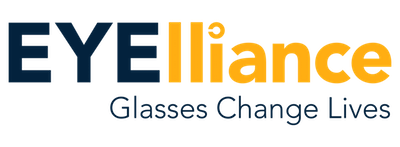What an ‘exit’ means at GDI: EYElliance finds new home at Tides Center
 As an incubator, GDI strives to ensure our initiatives are always working toward defined endgames. For some initiatives, this journey involves ‘exiting’ GDI after 24-36 months of partnership. We believe the focus on exits makes us more accountable to our funders and partners to help build initiatives that are sustainable beyond the first three stages of our “growth engineering” model. EYElliance – a coalition of multi-sector partners that collaborates to address the world’s unmet need for eyeglasses – recently exited GDI, and has now found a more permanent host at the Tides Center.
As an incubator, GDI strives to ensure our initiatives are always working toward defined endgames. For some initiatives, this journey involves ‘exiting’ GDI after 24-36 months of partnership. We believe the focus on exits makes us more accountable to our funders and partners to help build initiatives that are sustainable beyond the first three stages of our “growth engineering” model. EYElliance – a coalition of multi-sector partners that collaborates to address the world’s unmet need for eyeglasses – recently exited GDI, and has now found a more permanent host at the Tides Center.
Exits like these are important learning experiences for GDI. Below, GDI’s Andrew Stern and Moitreyee Sinha reflect on EYElliance’s transition, and what it means to see our theory of change in action.
Q: What was EYElliance like when GDI started to work with it? Where did it end up, and what was GDI’s role throughout that journey?
A: Jordan Kassalow, the Founder of VisionSpring, and Liz Smith, also with VisionSpring, had recognized that despite the great work and progress from VisionSpring, it was going to take more than one organization to reach the estimated 2.5 billion people around the world whose vision could be corrected with a pair of glasses. They saw the need to create a multi-stakeholder initiative to tackle the problem at scale, and started a conversation with GDI. After recognizing there was a need for a platform where different approaches and organizations could work together to achieve a common goal, they decided it made more sense for the effort to be an independent and neutral organization than a VisionSpring program.
At that point, GDI helped Jordan and Liz develop EYElliance’s first strategic plan, and facilitate strategic workshops with potential partners. We also supported the development of a business plan and helped brand the initiative alongside Emergence Creative. We were excited to see EYElliance launch their landmark report, “Eyeglasses for Global Development: Bridging the Divide,” in July 2016 at the WEF China with the endorsement of key figures like Madeline Albright and Walter Isaacson, and partnerships with industry and government players.
Q: What big strategic questions has EYElliance faced along the way?
A: One big question was what the endgame would be for eyeglass intervention. We recognized that some segments of need required more of a government adoption or partnership endgame, while other segments could be better served by a commercial or social enterprise model. In other words, reaching the 239 million schoolchildren who can’t see the chalkboard requires a different endgame than reaching factory workers who need glasses to do their jobs. The “open platform” model of EYElliance made sense because there isn’t a one-size-fits-all solution for eyeglass intervention.
Q: What made it clear that EYElliance was ready to exit GDI?
A: There were several factors. The report set a clear direction and roadmap for the initiative’s action. Behind the scenes, partners and funders had mobilized, and were having productive conversations. And finally, EYElliance had a well-functioning governance structure in place through its steering committee, and the team was growing.
Q: What kind of support does GDI continue offering its exited initiatives?
A: We offer ongoing advisory support, and will always be on the lookout for interesting opportunities, organizations, or people we think our exited initiatives should be aware of. Our success lies not just in helping initiatives stand on their own, but in their ongoing success and the ultimate impact they can create.
Q: What are the top three “lessons learned” from working with EYElliance? What would you do differently next time a similar initiative progresses through GDI to an exit?
A: GDI learned a lot from EYElliance, and hopefully they learned a lot from us. If we had to boil it down to three main takeaways, they would be:
- Great ideas and opportunities require both great leadership and management. When building a team, an early-stage initiative needs to think about complementing “big idea” thinkers with team members who can manage the day-to-day work, and vice versa. EYElliance has been able to strike that balance.
- Strategic discussions with partners take significant time and consultation. It is important to get all the stakeholders seeing the problem in the same way. With EYElliance, the group needed to align on how to define the scope of the problem and the number of people requiring eyeglasses (e.g., Do we say that there are 625 million vision impaired people around the world, or 2 billion people who need eyeglasses? In our case, we needed to use both framings to mobilize different actors and approaches). It took several working sessions, analyses, recommendations, and a public report to really solidify that alignment.
- Careful sequencing is key. Successful startups find a happy medium between spending time on strategic planning and business development, and going after quick wins. It can be a bit of a chicken-egg problem: It’s difficult to fundraise without showing progress and momentum, but hard to develop that progress with limited funding. Early stage initiatives need to sequence activities so that funding matches the creation of some near-term value.

